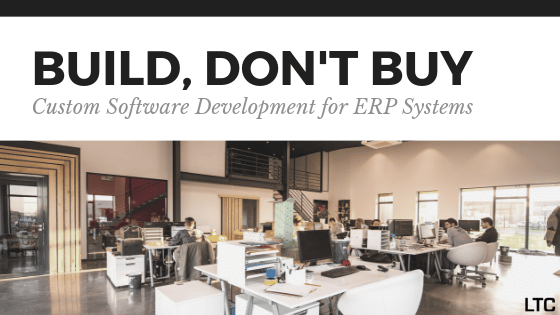If you think through your company departments, you’ll see that just about every department and responsibility relies on software. Consider all of the core processes used to run a company: accounting, human resources, customer service, manufacturing, and even management uses at least one, but often multiple software programs.
An ERP system, or Enterprise Resource Planning system, allows all of these different departments to use an integrated software system to improve communication, workflow, and visibility within and between departments. If your business has outgrown your current software system(s) or is looking to streamline operations and efficiency, you may be in the market for a new ERP system. But you’ve realized you have a choice: buy a pre-existing, out-of-the-box software system or build a completely custom software solution.
At LTC, not only do we recommend the “Build, Don’t Buy” approach for improved productivity and communication, it can also save you a large amount of money both in the short and long terms.
There are four main cons of “pre-packaged” software systems. While we’re focused specifically on ERP systems for this article, these are generally consistent across the spectrum of software solutions:

-
- General Solutions: To appeal to a wide array of companies, boxed software often is very generic and limited in scope – offering general solutions to your company’s specific problems. In the end, you’ll either end up with a software that doesn’t meet all of your needs or requires additional “connections” or other tools to work for your needs.
-
- Cost: One of the main reasons companies purchased packaged systems is because they are seen as cheap and easy. For one flat rate, you get a ready-to-go package that can be installed seemingly the next day. What you don’t see: the extra fees, the complex training, and the “flat rate” software that has suddenly tripled in price by the time “necessary adjustments” and add-ons are made.
-
- Resistance to Change: Even if the software you purchased for your company was perfect for your needs at the time, as you grow, these needs change. After purchase add-ons and service are not only difficult, they are expensive (on purpose). Development updates, and modern technology upgrades, occur only when the developer chooses to release them, not when you need them.
-
- Custom Upgrades: Fuhgeddaboudit.
Custom-Built ERP Software Solutions
One of the major misconceptions about custom software is the price. While the flat-rate of a packaged software may initially appear less, after add-ons, training, and hidden service fees, they often end up very near the same cost if not significantly more than a custom solution. In addition, the return on investment is even greater down the road.
-
- Custom software is designed to fit within your current company operating system and procedures.
-
- You don’t have to sacrifice an add-on feature due to the exorbitant cost even though it would be the perfect addition.
-
- As your business, technology, or industry changes, you can update your software quickly. For less money. And get back to work before your competitors.
While we can work within a current software solution or tailor-make an application to bridge workflows, our specialty is in custom software development. Throughout the entire software development process, we take your rough draft concept and work alongside you to validate your concept, set expectations, avoid unplanned bottlenecks and costs, and plan to not only fit your business timeline but also your budget.
Regardless of the type of custom software development you’re interested in, you can count on our team to deliver a fast, friendly, and affordable solution. Ready to learn more? We’d be happy to provide a free, no-pressure consultation!

